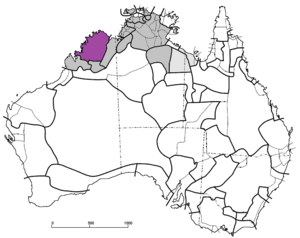Worrorran languages facts for kids
Quick facts for kids Worrorran |
|
|---|---|
| Geographic distribution: |
Northern Kimberley region, west of Wyndham |
| Linguistic classification: | One of the world's primary language families |
| Subdivisions: | |
 Map of the Worrorran languages
|
|
The Worrorran languages are a group of Australian Aboriginal languages. They are spoken in the northern part of Western Australia. These languages are found in the Kimberley region, west of the town of Wyndham.
The Worrorran languages are divided into three main groups, like different branches of a language tree:
- The Northern Worrorran group, which includes the Wunambal language and other similar ways of speaking.
- The Eastern Worrorran group, known as Ngarinyin (also called Ungarinyin) and its related dialects.
- The Western Worrorran group, which includes the Worrorra language and its dialects.
There is also a language called Gulunggulu. We don't have much information about it, but it is thought to be part of the Worrorran family.
Are Worrorran Languages Connected?
For a while, experts debated if the Worrorran languages were truly related. Some wondered if they were just spoken in the same area.
A linguist named Dixon (in 2002) thought they were separate languages. He believed they had no clear family link, only that they were spoken in the same region. This is like a "Sprachbund," where languages share features because they are close, not because they came from the same parent language.
However, more recent studies disagree with Dixon.
- Rumsey and McGregor (in 2009) showed that the languages are indeed connected. They found enough similarities to prove they belong to the same family.
- Bowern (in 2011) also agreed that the Worrorran languages form a single language family.
This means that most experts now believe these languages share a common ancestor.
Words in Worrorran Languages
When we study languages, looking at basic words helps us see how they are related. Here are some common words from different Worrorran languages. You can see how some words are similar, and others are quite different!
| English | Ungarinyin | Worora | Wunambal |
|---|---|---|---|
| man | aɽi, aɽu | idja | ɛndjin |
| woman | wɔŋai, wulun | wɔŋaiinja | wɔŋai |
| head | -alaŋgun | (ar)bri | waːra |
| eye | -ambul | ombula | wumbul |
| nose | -aiil | (ad)biŋu | windji |
| mouth | mindjäl | (ar)djamundu | mindjäl |
| tongue | anbula | anbula | anbulɛ |
| stomach | ŋujen, mandu | (ar)gulum | mɛːwur, mandu |
| bone | aːnɔr | inari | bunar |
| blood | guli | gulu | ŋanda |
| kangaroo | iali | aːrura | amba |
| emu | djebara | djebarinja | jiluluŋari |
| crow | wa̱ŋgara | wa̱ŋgaranja | waːwanja |
| sun | maɽaŋi | maraŋanja | maɽaŋo |
| moon | gunjili, gaɳgi | gunjila | goɽa, gaɳgi |
| fire | windjäŋun | wianu | windjäŋum |
| water | ŋabun | agu | jaːwal |
See also
 In Spanish: Lenguas worrorranas para niños
In Spanish: Lenguas worrorranas para niños


